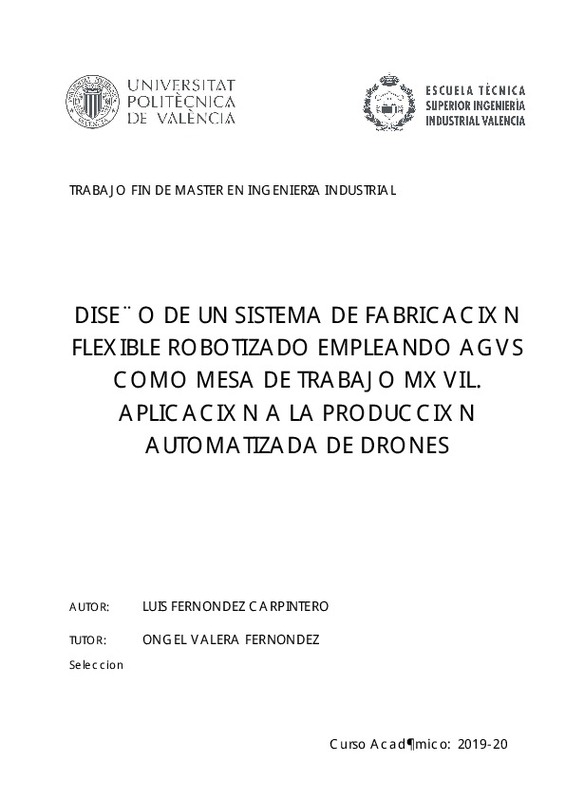|
Resumen:
|
[ES] La fabricación requiere reducir costes para obtener el máximo rendimiento y para ser competitivo. A su vez, el consumidor es más crítico y exigente, por lo que se requiere de procesos productivos que permitan fabricar ...[+]
[ES] La fabricación requiere reducir costes para obtener el máximo rendimiento y para ser competitivo. A su vez, el consumidor es más crítico y exigente, por lo que se requiere de procesos productivos que permitan fabricar según la demanda, en masa y en tiempo real. Además, se debe optimizar el espacio de trabajo en fabrica, así como los tiempos de proceso y, consecuentemente, reducir los tiempos de espera y de transporte del producto entre estaciones. Todos estos factores son característicos de la fabricación flexible. Si se añade como método de transporte los vehículos autoguiados, se logra flexibilizar al máximo la producción pudiendo elegir la ruta que seguirá y, adecuando los robots a las acciones requeridas. Con este proyecto se logra una fábrica automatizada la cual es gestionada por una sala de control encargada de coordinar las rutas y los programas de los robots.
Empleando la fabricación flexible con vehículos autoguiados, se logra fabricar un producto conforme el cliente lo pide, pudiendo tener toda la personalización que se reclame y, aun así, siendo competitivos. Por tanto, se puede satisfacer a muchos más clientes al proporcionarles productos hechos a la medida de las peticiones del consumidor. Mirando por el lado de la empresa, se puede compactar considerablemente la zona de fabricación puesto que se puede ir cambiando los programas de los robots para adecuarlos a las necesidades de la producción. Además, se verá reducido o incluso eliminado el espacio requerido para el almacenamiento de stock de producto terminado. Todo ello repercute en una notable reducción de costes, incremento de clientela y, por tanto, aumento de beneficios.
Para llevar a cabo este sistema de producción, se plantea diseñar una línea de fabricación de drones, a modo de ejemplificación del potencial de optimización de la producción que se puede obtener empleando los AGVs con la fabricación flexible. Estará compuesta por diversos robot los cuales realicen tareas como el posicionamiento de las piezas, soldadura, aplicación de adhesivos o pintura.
Se va a diseñar un vehículo autoguiado junto a una mesa de trabajo donde se transportará las diferentes piezas y se efectuarán las diversas operaciones. Se contemplarán numerosas versiones o personalizaciones de los drones pudiendo variar el número de hélices, si lleva o no cámara y la capacidad de esta, las baterías, el sistema de emisión de señal o el tren de aterrizaje.
Para la gestión, monitorización y gestión de la planta, se ilustrará todo el conjunto en un SCADA, pudiendo verse el estado de cada robot y AGV.
En general, se va a proponer un método de trabajo que combine el potencial de fabricación flexible con la movilidad y capacidad de decisión ágil que permiten los vehículos autoguiados, el cual se simulará en una planta de fabricación de drones y se hará el seguimiento a través de un SCADA
[-]
[EN] Manufacturing requires reducing costs to obtain maximum performance and to be competitive.
In turn, the consumer is more critical and demanding, which is why production processes are
required that allow manufacturing ...[+]
[EN] Manufacturing requires reducing costs to obtain maximum performance and to be competitive.
In turn, the consumer is more critical and demanding, which is why production processes are
required that allow manufacturing according to demand, in mass and in real time. In addition,
the workspace in the factory must be optimized, as well as the process times and, consequently,
the waiting and transport times of the product between stations must be reduced. All these
factors are characteristic of flexible manufacturing. If self-guided vehicles are added as a
transport method, production can be made as flexible as possible by choosing the route to
follow, adapting the robots to the required actions. With this project an automated factory is
achieved which is managed by a control room in charge of coordinating the routes and programs
of the robots.
Using flexible manufacturing with self-guided vehicles, it is possible to manufacture a product
according to the customer's request, being able to have all the customization that is claimed
and, even so, being competitive. Therefore, many more customers can be satisfied by providing
products tailored to consumer requests. Looking from the company side, the manufacturing
area can be considerably compacted since the robot programs can be changed to adapt them to
the production needs. In addition, the space required for storing finished product stock will be
reduced or even eliminated. All this results in a notable reduction in costs, an increase in
customers and, therefore, an increase in profits.
To carry out this production system, it is proposed to design a drone manufacturing line, as an
example of the potential for optimizing production that can be obtained using AGVs with flexible
manufacturing. It will be made up of various robots that carry out tasks such as positioning the
parts, welding, applying adhesives or painting.
A self-guided vehicle will be designed together with a worktable where the different parts will
be transported and the various operations will be carried out. Numerous versions or
customizations of the drones will be considered, and the number of propellers may vary,
whether or not it carries a camera and its capacity, the batteries, the signal emission system or
the landing gear.
For the management, monitoring and management of the plant, the whole set will be illustrated
in a SCADA, being able to see the status of each robot and AGV.
In general, a working method will be proposed that combines the potential for flexible
manufacturing with the mobility and agile decision-making capacity that self-guided vehicles
allow, which will be simulated in a drone manufacturing plant and monitored through of a
SCADA.
[-]
|







